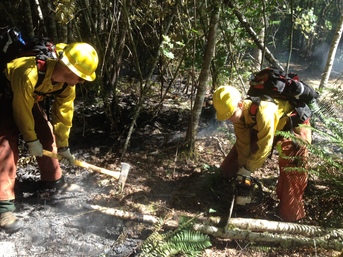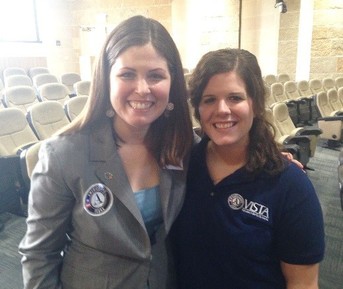|
On June 17, a crew of 6 AmeriCorps members and staff were
dispatched to suppress a 20 acre fire burning near the community of Rockport,
Washington.

On May 19, 2015, crude oil was discovered to be coming out
of a transmission pipeline at a Culvert under Highway 1 in Santa Barbara
County, CA. A quarter mile sheen was
observed off of Refugio State Beach, prompting a closure of the beach. More than 100,000 gallons of oil was reported
being spilled.
Officials called upon the State Service Commission; CaliforniaVolunteers (CV) to assist
with management of volunteers, and directed those wishing to help to the CV
website. The following morning, Suu-Va
Tai, CV Director of Disaster Volunteering and Preparedness traveled to the
site, and Governor Edmund G. Brown Jr. declared a state of emergency to assist
the oil spill response.
CV worked with the California Department of
Fish and Wildlife Office of Oil Spill Prevention and Response, as well as the
Santa Barbara County CERT (Community Emergency Response Team) to organize
training classes for spontaneous volunteers who wished to help. With less than 24-hours’ notice during the
holiday, more than 30 CERT volunteers responded to the request for assistance
in training. The training provided the
spontaneous volunteers the appropriate training need in order to safely
respond and assist with the clean-up.
More than 260 volunteers have
been trained and nearly 160 have participated in four clean-up efforts.
  By Dani Rosati
Nothing can truly
prepare one for disaster relief efforts other than experiencing it firsthand. I am currently
serving as an AmeriCorps VISTA member at OneStar Foundation in Austin, Texas. A
week after flooding from the Blanco River had devastated nearby towns, and, as
the waters were still receding, I headed to Wimberley, Texas to help in the
recovery efforts. My placement was at the Volunteer Reception Center, led
by Texas Conservation Corps and located at Cypress Creek Church near downtown
Wimberley. As I arrived in the early morning, I saw donations pouring in, food
being prepared, and already a line of volunteers out the door. Seeing the support this community was
receiving nearly overwhelmed me.
During the next eight
hours, I was able to witness the ins and outs, challenges and hard work it
takes to run a VRC and it was an invaluable experience. VRC Coordinators set me
up at a table to distribute waiver release forms, document tools/equipment
volunteers were taking with them to their sites, help keep track of who was
going where, and, in general, to answer questions and direct the many people
arriving to volunteer. Without logistical coordination, attention to detail, and
strong leadership, a situation like this can turn to chaos very quickly. Not
only did VRC members have to communicate clearly with the volunteers looking to
be assigned to a disaster site, but they also needed to have the most
up-to-date information from members working at the various house sites,
AmeriCorps volunteers in other positions around town, bus drivers, church members,
and a myriad of others who had come to serve. People showed up from all walks
of life to help in whatever capacity they could. There were children, couples,
neighbors, veterans, people who were elderly, construction workers, and the
list went on and on. I learned that it
truly takes a community to get things done - whether that be preparing/distributing
food, sorting/distributing donations, fundraising, coordinating volunteers, or performing
manual labor. Like a body, no one part can function without the others.
In the news, it
is often those working directly in the field performing manual labor who are
shown - repairing destroyed homes, clearing debris, cutting down dead trees,
etc. However, a side one doesn’t often see is the behind-the-scenes work of
those coordinating the efforts. As for
me, I have now seen a snapshot of what it takes to make this process run
smoothly and feel humbled to have been one small piece of the puzzle.
|